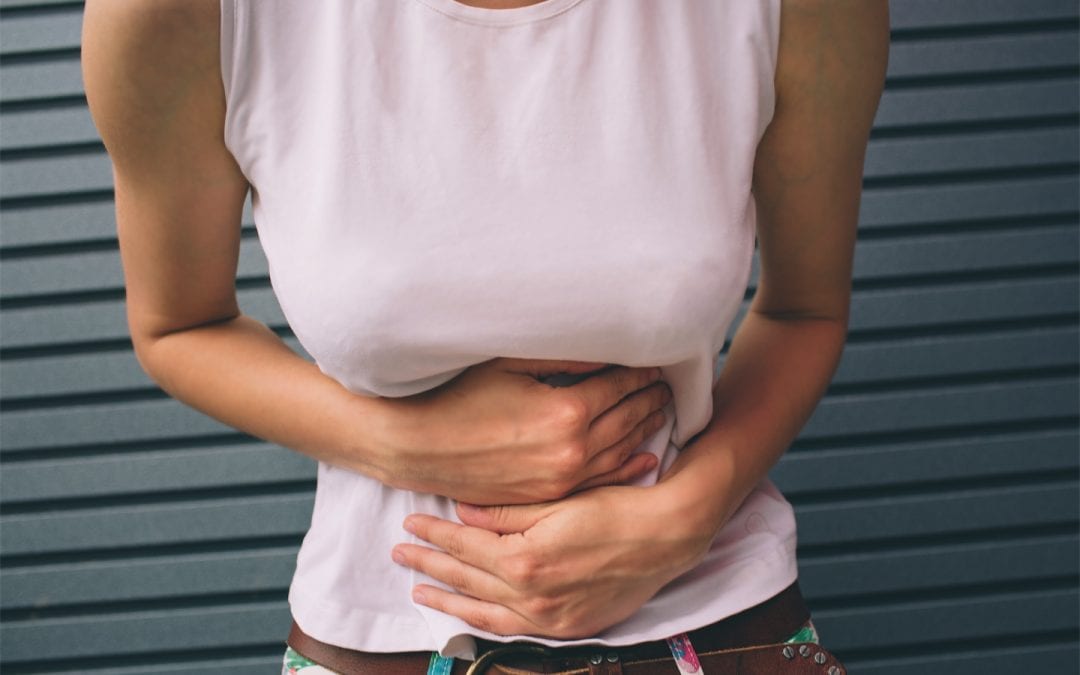Do you regularly experience severe bloating around 60-90 minutes after eating, have diarrhoea and/or constipation? Are you unable tolerate an increasing number of foods that you used to be able to eat such as dairy, fruit, starchy vegetables and grains? Did your symptoms start after a gastrointestinal infection, a course of antibiotics or prescription of a proton pump inhibitor? Have you been diagnosed with irritable bowel syndrome but the treatment is not resolving symptoms? You may be experiencing small intestinal bacterial overgrowth (SIBO).
As the name indicates, SIBO occurs when there is an increase in the number and type of bacteria in your small intestine 1. In healthy individuals, the number of bacteria in this part of the digestive tract is usually minimal. This is in contrast to the large intestine, which has an abundance of bacteria. These colonic bacteria work hard for your health – aiding digestion, neutralising harmful substances, producing vitamins such as Vitamin K and biotin, keeping pathogenic bacteria and fungus levels low and producing substances that support immunity and reduce inflammation 2. In SIBO the same bacteria that are doing great work in your colon create havoc when they take up residence in your small intestine. The small intestine is not built for their kind of party!
Risk factors for SIBO
Low stomach acid (hypochlorhydria)
Stomach acid is one of the ways your body controls pathogens in the digestive tract and ensures bacteria from the colon can’t move into your small intestine. Low stomach acid can be caused by ongoing stress, ageing (levels decline in your 60s and 70s), and use of acid blocking drugs such as proton pump inhibitors, antacids and H2 blockers 3.
Lack of enzymes released from the pancreas
This could be due to an issue with either the production or release of pancreatic enzymes. It often is linked to low stomach acid. The release of acidic contents from the stomach valve (pyloric sphincter) into the upper part of the small intestine triggers the pancreas to release digestive enzymes. If the contents of your stomach aren’t acidic enough the pancreas doesn’t get the signal it needs to release these enzymes 4.
Reduced peristalsis
If you have a condition that impacts on gastrointestinal motility (peristalsis) such as scleroderma, autonomic neuropathy sometimes seen in type 2 diabetes, post radiation complications and hypothyroidism 5,6.
Damage to your migrating motor complex (MMC)
This is separate movement from peristalsis. The MMC is a cleansing wave that occurs every 90 minutes when your stomach is empty and flushes out any indigestible material and bacteria from the small intestine into the colon. It’s the grumbling, and growling sounds your stomach makes between meals. The MMC can be impaired as a result of infectious gastroenteritis, inflammatory bowel disease, recurrent antibiotics and some medications such as opiates 2.
Structural abnormalities
Any structural abnormality of the digestive tract such as obstructions, tumours and adhesions from abdominal surgery including C-sections, laparoscopy, appendectomy, gastric bypass or gallbladder removal 1.
Key symptoms of SIBO are:
- Bloating and pain after eating or even with water
- Pain under sternum or around the diaphragm
- Nausea
- Diarrhoea and/or constipation
- Weight loss
- Anemia
- Fatigue
- Symptoms worse when probiotics or fermented foods are consumed
- Symptoms improve when on antibiotics
SIBO may also be associated with:
- Skin rashes
- Joint pain
- Rosacea 5
- Restless Leg syndrome7
- Coeliac disease that doesn’t improve with elimination of gluten 1
Is there a test for SIBO?
Yes – the gold standard is a jejunal aspirate and biopsy. This is highly sensitive and specific, but it is an invasive test 8.
A non-invasive option which also has strong clinical relevance is a breath test using lactulose and/or glucose. This test is explained in detail here.
A stool test, while useful for other aspects of digestive health is not diagnostic for SIBO.
How is SIBO treated
SIBO has many potential causes, so treatment plans need to be individualised and address not only the symptoms but also the underlying cause.
The medical approach may include diet modification, antibiotics and the use of medicines to promote motility.
Naturopathic approach to SIBO
The naturopathic approach involves temporary diet change to reduce symptoms and support initial healing. It is important to note that any restriction of foods should be short term only. Many of the foods that exacerbate SIBO symptoms (typically FODMAPS foods) are important for ongoing health and feeding the beneficial colonic bacteria.
* Improving the health of the gastrointestinal tract to reduce inflammation, support appropriate secretion of stomach acid and digestive enzymes and restore motility.
* Use of antimicrobial and antifungal herbs to reduce bacteria in the small intestine and deal with any overgrowth of pathogenic bacteria. This should be done in conjunction with a person who is appropriately qualified as herbal antimicrobials need to be used cautiously and appropriately.
* Support a diversity of beneficial bacteria in the colon
* Naturopathic support of any underlying condition contributing to SIBO.
How long will treatment take?
This depends on individual factors and underlying causes but as a minimum Naturopathic treatment would take at least three months.
If you’ve got any questions or would like to know more about SIBO and the Naturopathic approach, please get in touch.
References:
- Bures J. Small intestinal bacterial overgrowth syndrome. World J Gastroenterol. 2010;16(24):2978-2990. doi:10.3748/wjg.v16.i24.2978.
- Jacobs C, Coss Adame E, Attaluri A, Valestin J, Rao SSC. Dysmotility and proton pump inhibitor use are independent risk factors for small intestinal bacterial and/or fungal overgrowth. Aliment Pharmacol Ther. 2013;37(11):1103-1111. doi:10.1111/apt.12304.
- Bested AC, Logan AC, Selhub EM. Intestinal microbiota, probiotics and mental health: from Metchnikoff to modern advances: Part II – contemporary contextual research. Gut Pathog. 2013;5(1):1-14. doi:10.1186/1757-4749-5-3.
- Owens SR, Greenson JK. The pathology of malabsorption: current concepts. Histopathology. 2007;50(1):64-82. doi:10.1111/j.1365-2559.2006.02547.x.
- Gabrielli M, D’Angelo G, Di Rienzo T, Scarpellini E, Ojetti V. Diagnosis of small intestinal bacterial overgrowth in the clinical practice. Eur Rev Med Pharmacol Sci. 2013;17(Suppl 2):30-35. http://www.ncbi.nlm.nih.gov/pubmed/24443065. Accessed September 12, 2014.
- Pyleris E, Giamarellos-Bourboulis EJ, Tzivras D, Koussoulas V, Barbatzas C, Pimentel M. The prevalence of overgrowth by aerobic bacteria in the small intestine by small bowel culture: relationship with irritable bowel syndrome. Dig Dis Sci. 2012;57(5):1321-1329. doi:10.1007/s10620-012-2033-7.
- Weinstock LB, Fern SE, Duntley SP. Restless legs syndrome in patients with irritable bowel syndrome: Response to small intestinal bacterial overgrowth therapy. Dig Dis Sci. 2008;53(5):1252-1256. doi:10.1007/s10620-007-0021-0.
- De Palma G, Collins SM, Bercik P. The microbiota-gut-brain axis in functional gastrointestinal disorders. Gut Microbes. 2014;5(3):419-429. doi:10.4161/gmic.29417.

Need help with your gut health?
Norelle Hentschel is an experienced Naturopath with a clinic in Stones Corner, Brisbane who enjoys supporting her clients to reach their health goals.
Want more articles like this?
Receive a monthly digest of natural health information to help you become “health” sufficient!
PS. Your inbox real estate is precious, and we will never annoy you with sales pitches or share your details with anyone else. One email a month — that’s it.

